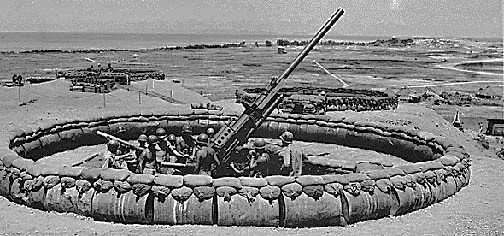
| Year | May 1941 (M1A1) May 1943 (M2) |
| Weapon Type | [@type] |
| Origin & Designer | [@designer] |
| Numbers Produced | 6.648 (M1A |
| Crew | Sergeant/Squad Leader + .30 cal M1 Rifle. Corporal/Gunner + .30 cal M1 Carbine. Pvt/Assistant Gunner + .30 cal M1 Carbine. Pvt/Elevation Setter + .30 cal M1 Carbine. Pvt/Fuse Setter + .30 cal M1 Carbine. Pvt/Fuse Range Setter + .30 cal M1 Carbine. Pvt/Azimuth Setter + .30 cal M1 Carbine. 3 x Pvts/Loaders + .30 cal M1 Carbines. Corporal/Ammunition + .30 cal M1 Carbine. 4 x Pvts/Ammunition Bearers + .30 cal M1 Carbines. Pvt/Driver (Tractor) + .30 cal M1 Rifle w/M7 Grenade Discharger. |
| Calibre | 90mm (90x600R) |
| Elevation | M1A1: -0° to +80° M2: -10° to +80°. |
| Traverse | 360° |
| Breech | Semi-Automatic |
| Recoil | Hydropneumatic |
| Gun Sight | M24 |
| Gun Mount | [@gun_mounts] |
| Carriage | M1 (M1A1) M2 (M2) |
| Trailers | [@trailers] |
| Gun Shield | [@gun_shield] |
| Armoured Plate | [@armoured_plate] |
| Barrel Length | 4.5m (L/50) |
| Overall Length | 9.021m |
| Width | 4.16m |
| Height | 3.07m |
| Weight | Weight in Transit: M1A1 11.090 kg / M2 17.812 kg. Weight in Action: M1A1 8.618 kg / M2 14.651 kg. |
| Round Weight | AP (M77) 10.91 kg. HE (M71) 10.610 kg. |
| Muzzle Velocity | AP 853 m/s. HE 823 m/s. |
| Feed | [@feed] |
| Magazine Capacity | [@magazine_capacity] |
| Practical Rate of Fire | [@practical_rate_of_fire] |
| Rate of Fire | [@rate_of_fire] |
| Maximum Rate of Fire | 25 rpm (M1A1) 28 rpm (M2) |
| Maximum Ceiling | 12.040m |
| Maximum Ground Range | 17.823m |
| Maximum Range | [@maximum_range] |
| Armour Penetration | 130mm @ 500m @ 30° |
| Traction | M4 Tractor |
| Variants | [@variants] |
| Notes | In 1938 the US army issued contracts for a new anti-aircraft gun, up to then the army had mainly used the 3in as their primary AA gun. The wanted a weapon with a calibre of 90mm and capable of manual loading at maximum elevation. The new design was called the 90mm M1 and around two hundred were made before the improved M1A1 came into service. The M1A1 had an improved mount and breech which included a spring rammer which increased the rate of fire. The M1A1 became the standard 90mm anti-aircraft gun when the US entered the war. The M2 was a new design which allowed the gun to engage ground targets such as armour. It had a new automatic fuse setter and rammer which increased the rate of fire and could depress down as low as -10 degrees. An armoured shield protected the crew and it could be made ready to fire from its wheeled carriage in three minutes and from the ground in seven minutes. Both the M1A1 and M2 saw action in the Korean War until withdrawn when the emphasis changed to missile technology. |